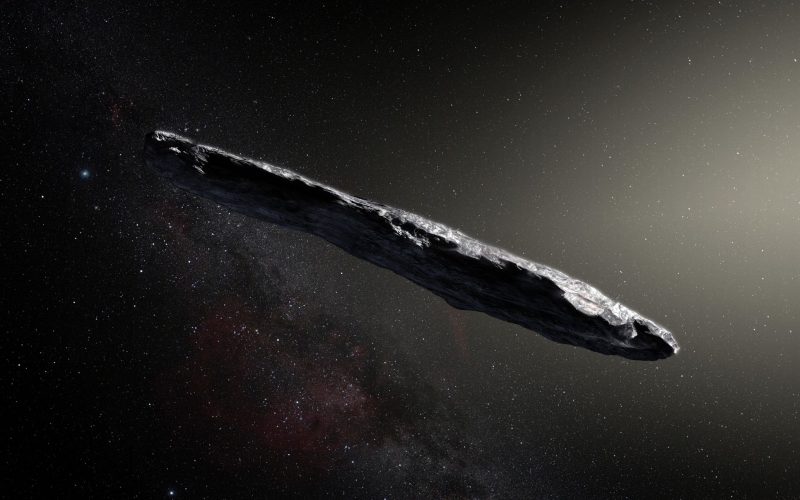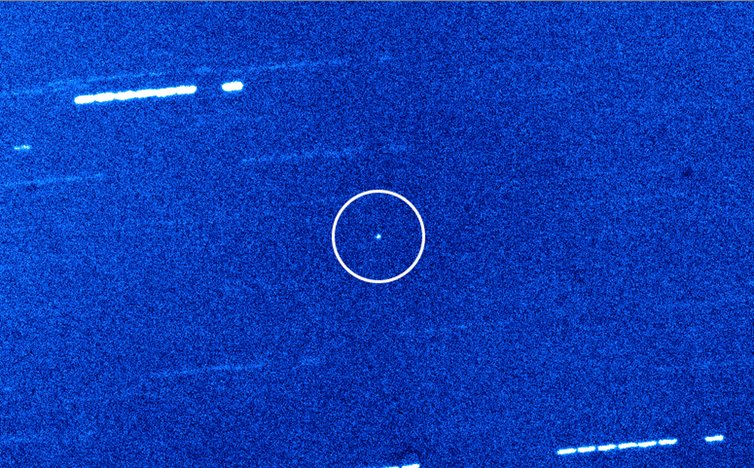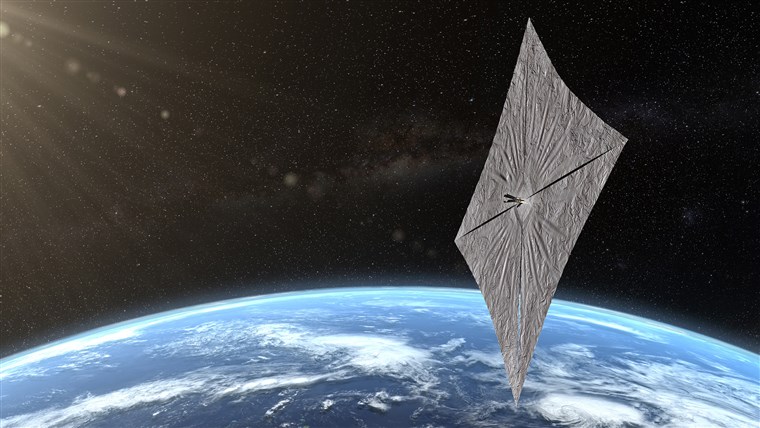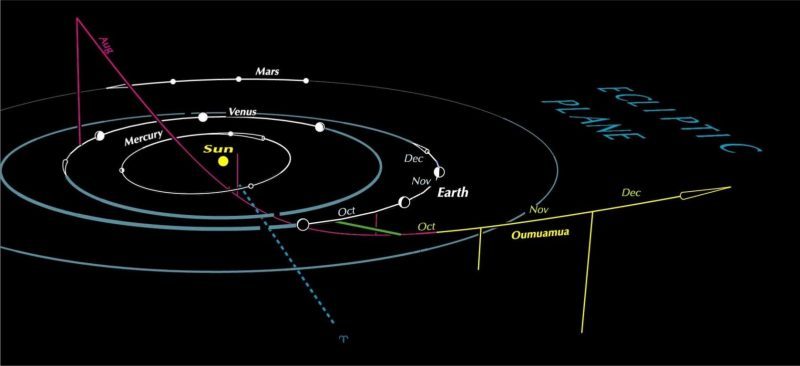

Artist’s concept of ‘Oumuamua, whose actual appearance is unknown. This illustration is based on the limited observations available. What was ‘Oumuamua? We know it entered our solar system – swept near our sun on September 9, 2017 – then headed back to interstellar space again. Astronomers are still trying to piece its story together. Image via ESO/ M. Kornmesser.
When astronomers first spied ‘Oumuamua – in the fall of 2017 – they weren’t sure if it was one of our solar system’s asteroids or comets, or something else. It turned out to be an interstellar interloper, the first-known interstellar object. The astronomers watched it speed through the solar system, disappearing from view of even the largest earthly telescopes around January 2018 … as theories about its odd shape and behavior raged. Some said it was an unusually long asteroid. Others even proposed an extraterrestrial spacecraft, reminiscent of the one in Arthur C. Clarke’s famous sci-fi novel “Rendezvous with Rama.” The astronomers eventually settled on its being either an asteroid or comet from another solar system, albeit a weird one.
Now there’s a new idea. ‘Oumuamua might not be an interstellar asteroid or comet, but instead something never seen before: neither ice nor rock, but rather a very lightweight and “fluffy” conglomerate of dust and ice grains, sort of like a “cosmic dust bunny.” The new peer-reviewed research was published in The Astrophysical Journal Letters on November 11, 2019.
The study suggests that ‘Oumuamua might be so porous that sunbeams could actually push it and give it its observed momentum.
When ‘Oumuamua was first found, it was already on its way out of the solar system, so there was limited time to observe it, and it was already far away in the outer solar system. But astronomers did notice something odd: it was increasing slightly in speed. Comets could do that, as they lost ice and dust particles behind them in their tails. But ‘Oumuamua didn’t have any tail at all.
EarthSky 2020 lunar calendars are available! They make great gifts. Order now. Going fast!

Our best view of ‘Oumuamua – from the William Herschel Telescope on the island of La Palma in the Canary Islands, Spain – on October 29, 2017. Image via A. Fitzsimmons, QUB/Isaac Newton Group of Telescopes.
So what else could cause the object to increase in speed? One idea was that sunlight itself was responsible. But that wouldn’t work if it was an asteroid, as it would require a very large flat surface to catch enough of the light particles from the sun. This led to the even wilder possibility that ‘Oumuamua was artificial, something like a large flat light sail.
But then another possibility was posited by Amaya Moro-Martín, an astronomer at the Space Telescope Science Institute. ‘Oumuamua might be “fluffy,” a lightweight conglomerate of dust and ice grains, known as a fractal aggregate. In essence, a dust fractal or “cosmic dust bunny.” The porous patterns in it would be repeated across different size scales, like a fractal. As co-author Eirik Flekkøy, a physicist at the University of Oslo, stated:
It’s a completely new thing. I think if you hit this thing it would be a little bit like hitting a spider web.
Could such a delicate structure actually travel through space – between stars – and survive? Flekkøy and his colleagues decided to test that idea. Something else that had been observed, a slowing in the object’s rotation, would fit the theory since the speed of the slowing was observed to fit with a phenomenon where light can push harder on some parts of a surface – such as shinier parts – than it pushes on others. If ‘Oumuamua could be turned by sunbeams alone, then it could be sped up, as well. The theory is that when the object cools after being heated up by the sun, the departure of heat also exerts gentle pushes. The uneven nudges could add up to make a lumpy object spin faster or slower over time.

Artist’s illustration of a light sail. Some people have speculated that ‘Oumuamua could be an alien version of something similar, but larger. Image via Josh Spradling/The Planetary Society.
This could explain the object’s slowing rotation and increase in speed, but would such a lightweight structure hold together? According to Flekkøy:
If this is such a filamentary, porous, fractal structure, would it survive. And the answer is fairly safely, yes.
Other researchers are doubtful about this explanation, however. They point out that the way ‘Oumuamua responded to sunlight would require it to be 100 times less dense than air at sea level. Scientists can now create similar lightweight materials – called aerogels – but the material ‘Oumuamua would be composed of would need to be even lighter than that. As Roman Rafikov, an astrophysicist at the University of Cambridge, pointed out:
How do you reconstruct this in interstellar space?
The idea that ‘Oumuamua could be a cosmic dust bunny of sorts is a strange one, although it might have some basis in reality. Smaller versions of this are thought to have been possible in the early solar system, forming from small particles bumping into each other. But to survive, and be able to cross interstellar space, such a dust bunny would need to grow larger. At the moment though, Rafikov doesn’t have any better suggestions:
If I had an alternative, I would have published it long ago.

The trajectory of ‘Oumuamua through the solar system. Image via Universal Workshop.
Of course, this also brings up the speculative possibility of such an object being made artificially by some advanced civilization, much like our own aerogels, but an obvious question would be “why?” Unfortunately, ‘Oumuamua is now too far away to do any further studies, so its actual nature will probably always remain a mystery.
On August 30 of this year, the second-known interstellar object was discovered – called C/2019 Q4 (Borisov) – but this one appears to have the characteristics of a normal comet. So why was ‘Oumuamua so weird? We’ll probably never know. But if anything like it shows up again, we may be better prepared to study it, according to Rafikov:
In my career so far, ‘Oumuamua was the most puzzling object. If [similar objects] actually keep coming into our solar system, we might be better prepared for this kind of analysis.
Bottom line: ‘Oumuamua – the weird object that entered our solar system a few years ago – may not be an asteroid or comet at all, but rather a “cosmic dust bunny.”
Source: The Interstellar Object ‘Oumuamua as a Fractal Dust Aggregate
from EarthSky https://ift.tt/2pRrZJb


Artist’s concept of ‘Oumuamua, whose actual appearance is unknown. This illustration is based on the limited observations available. What was ‘Oumuamua? We know it entered our solar system – swept near our sun on September 9, 2017 – then headed back to interstellar space again. Astronomers are still trying to piece its story together. Image via ESO/ M. Kornmesser.
When astronomers first spied ‘Oumuamua – in the fall of 2017 – they weren’t sure if it was one of our solar system’s asteroids or comets, or something else. It turned out to be an interstellar interloper, the first-known interstellar object. The astronomers watched it speed through the solar system, disappearing from view of even the largest earthly telescopes around January 2018 … as theories about its odd shape and behavior raged. Some said it was an unusually long asteroid. Others even proposed an extraterrestrial spacecraft, reminiscent of the one in Arthur C. Clarke’s famous sci-fi novel “Rendezvous with Rama.” The astronomers eventually settled on its being either an asteroid or comet from another solar system, albeit a weird one.
Now there’s a new idea. ‘Oumuamua might not be an interstellar asteroid or comet, but instead something never seen before: neither ice nor rock, but rather a very lightweight and “fluffy” conglomerate of dust and ice grains, sort of like a “cosmic dust bunny.” The new peer-reviewed research was published in The Astrophysical Journal Letters on November 11, 2019.
The study suggests that ‘Oumuamua might be so porous that sunbeams could actually push it and give it its observed momentum.
When ‘Oumuamua was first found, it was already on its way out of the solar system, so there was limited time to observe it, and it was already far away in the outer solar system. But astronomers did notice something odd: it was increasing slightly in speed. Comets could do that, as they lost ice and dust particles behind them in their tails. But ‘Oumuamua didn’t have any tail at all.
EarthSky 2020 lunar calendars are available! They make great gifts. Order now. Going fast!

Our best view of ‘Oumuamua – from the William Herschel Telescope on the island of La Palma in the Canary Islands, Spain – on October 29, 2017. Image via A. Fitzsimmons, QUB/Isaac Newton Group of Telescopes.
So what else could cause the object to increase in speed? One idea was that sunlight itself was responsible. But that wouldn’t work if it was an asteroid, as it would require a very large flat surface to catch enough of the light particles from the sun. This led to the even wilder possibility that ‘Oumuamua was artificial, something like a large flat light sail.
But then another possibility was posited by Amaya Moro-Martín, an astronomer at the Space Telescope Science Institute. ‘Oumuamua might be “fluffy,” a lightweight conglomerate of dust and ice grains, known as a fractal aggregate. In essence, a dust fractal or “cosmic dust bunny.” The porous patterns in it would be repeated across different size scales, like a fractal. As co-author Eirik Flekkøy, a physicist at the University of Oslo, stated:
It’s a completely new thing. I think if you hit this thing it would be a little bit like hitting a spider web.
Could such a delicate structure actually travel through space – between stars – and survive? Flekkøy and his colleagues decided to test that idea. Something else that had been observed, a slowing in the object’s rotation, would fit the theory since the speed of the slowing was observed to fit with a phenomenon where light can push harder on some parts of a surface – such as shinier parts – than it pushes on others. If ‘Oumuamua could be turned by sunbeams alone, then it could be sped up, as well. The theory is that when the object cools after being heated up by the sun, the departure of heat also exerts gentle pushes. The uneven nudges could add up to make a lumpy object spin faster or slower over time.

Artist’s illustration of a light sail. Some people have speculated that ‘Oumuamua could be an alien version of something similar, but larger. Image via Josh Spradling/The Planetary Society.
This could explain the object’s slowing rotation and increase in speed, but would such a lightweight structure hold together? According to Flekkøy:
If this is such a filamentary, porous, fractal structure, would it survive. And the answer is fairly safely, yes.
Other researchers are doubtful about this explanation, however. They point out that the way ‘Oumuamua responded to sunlight would require it to be 100 times less dense than air at sea level. Scientists can now create similar lightweight materials – called aerogels – but the material ‘Oumuamua would be composed of would need to be even lighter than that. As Roman Rafikov, an astrophysicist at the University of Cambridge, pointed out:
How do you reconstruct this in interstellar space?
The idea that ‘Oumuamua could be a cosmic dust bunny of sorts is a strange one, although it might have some basis in reality. Smaller versions of this are thought to have been possible in the early solar system, forming from small particles bumping into each other. But to survive, and be able to cross interstellar space, such a dust bunny would need to grow larger. At the moment though, Rafikov doesn’t have any better suggestions:
If I had an alternative, I would have published it long ago.

The trajectory of ‘Oumuamua through the solar system. Image via Universal Workshop.
Of course, this also brings up the speculative possibility of such an object being made artificially by some advanced civilization, much like our own aerogels, but an obvious question would be “why?” Unfortunately, ‘Oumuamua is now too far away to do any further studies, so its actual nature will probably always remain a mystery.
On August 30 of this year, the second-known interstellar object was discovered – called C/2019 Q4 (Borisov) – but this one appears to have the characteristics of a normal comet. So why was ‘Oumuamua so weird? We’ll probably never know. But if anything like it shows up again, we may be better prepared to study it, according to Rafikov:
In my career so far, ‘Oumuamua was the most puzzling object. If [similar objects] actually keep coming into our solar system, we might be better prepared for this kind of analysis.
Bottom line: ‘Oumuamua – the weird object that entered our solar system a few years ago – may not be an asteroid or comet at all, but rather a “cosmic dust bunny.”
Source: The Interstellar Object ‘Oumuamua as a Fractal Dust Aggregate
from EarthSky https://ift.tt/2pRrZJb

Aucun commentaire:
Enregistrer un commentaire